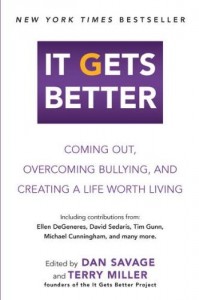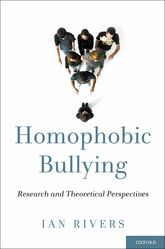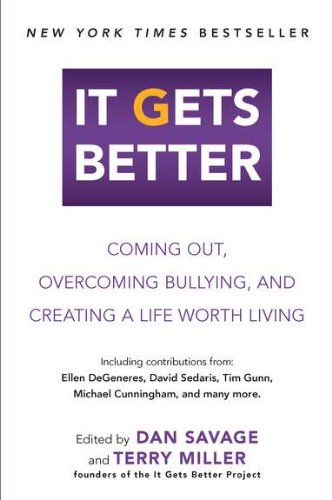 It Gets Better: Coming Out, Overcoming
It Gets Better: Coming Out, Overcoming
Bullying, and Creating a Life Worth Living
Edited by Dan Savage and Terry Miller
Dutton. 338 pages, $21.95
 Homophobic Bullying: Research and Theoretical Perspectives
Homophobic Bullying: Research and Theoretical Perspectives
by Ian Rivers
Oxford University Press. 232 pages, $35.
THE SUMMER OF 2010 was either a goldmine or minefield for news junkies, depending on your appetite for negativity. An oil spill of unprecedented size, two seemingly endless wars, and freeways fraught with out-of-control Toyotas made the usual roster of natural disasters seem tame in comparison. More of us were at home watching TV news than usual, too, waiting for the announcement that the economy is righting itself and we can maybe go back to work sometime this century. There was no lack of badness to focus on, so it took a little longer for their names to register. Justin Aaberg. Billy Lucas. Tyler Clementi. By the time we were paying attention, there were four more names added to the list. Seven young men, each bullied or tormented for being, or perceived as being, gay—and each of them had taken his own life. What was happening?
An “outsider” might be perplexed by this question, but any gay adult who survived high school probably flashed on those years. It’s not hard to find stories about the cruelty that gay youths have suffered at the hands of peers or teachers or both. Adolescence is the worst time to be seen as different, and sexuality is a topic that kids will seize upon to torment one another. What survivors of that time also know is that, for most of us, things improved after high school, sometimes instantly.
That’s the simple message that Dan Savage wants to convey in It Gets Better, which started as a YouTube video. Tired of being asked to speak at colleges but never middle schools, he saw YouTube as a way to reach those who needed a message of hope but didn’t know where to turn. Savage and husband Terry Miller posted a video and invited others to do the same, expecting at most a hundred or so to appear. But by the time of the book’s release, there were over ten thousand videos running on the resulting website (itgetsbetter.org). They came from all corners of the globe and cut across every class and creed. Each tried to get the same message across: it may be hard now, but hang on and it will get better.
The “It Gets Better” campaign was described in this magazine as “a transformative cultural moment” in that it forced people to confront bullying as an authentic social problem, like poverty or crime. Writes Savage in the book’s introduction: “By giving ourselves permission to speak directly to LGBT youth, Terry and I gave permission to all LGBT adults everywhere to speak to LGBT youth. It forced straight people—politicians, teachers, preachers, and parents—to decide whose side they were on.”
It Gets Better features 111 messages, some transcribed from video, by everyone from poor rural lesbians to presidents and prime ministers. The diversity of the participants is an important feature. Following several entirely heartfelt messages from rich and famous people whose lives are pretty damn good, there follows an essay by one Gabrielle Rivera, who starts out saying: “As a gay woman of color, I just want to let the youth know that it kind of doesn’t get better.” She goes on to argue that “it” doesn’t get better so much as “you” become a stronger and smarter person who is better able to adapt to life’s lemons, even if your Lotto number doesn’t come up.
The messages from politicians are as stuffy and awkward as one might expect, but endearingly so. British Prime Minister David Cameron emphasizes the UK’s progress toward tolerance: “Britain is a place where you can be who you want to be and we should celebrate that.” Entries from Cameron, President Obama, Senator Al Franken, and other politicians, while far from the more emotionally raw pieces in this book, nevertheless make a powerful argument against anti-gay bullying from the perspective of those who haven’t experienced it firsthand.
Those seeking a better understanding of the problems encountered by the victims of bullying will find another book, Homophobic Bullying by Ian Rivers, a useful work of scholarship. Rivers compiled data from numerous studies on the form and nature of the problem and created a curriculum to help eliminate bullying in schools, starting in kindergarten with the simple message that there are different types of families, and progressing all the way through high school with lessons on the consequences that follow from homophobic taunting and exclusion.
Homophobic Bullying is an academic work, written with the emotional detachment of the genre. The personal accounts from victims, while gripping, are brief and scattered throughout the text. However, the curriculum and supporting data make this a treasure trove for anyone creating change in a school or workplace. It Gets Better belongs on the shelves of every middle school library in this country; Homophobic Bullying should be in the principal’s office.
________________________________________________________
Heather Seggel is a writer living in Ukiah, California. Before her freshman year in high school was over, she had perfected the art of social camouflage.






